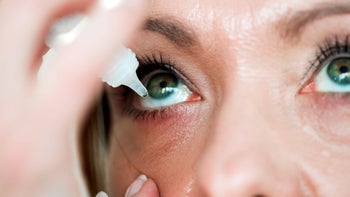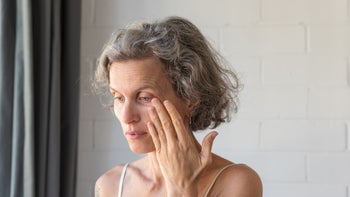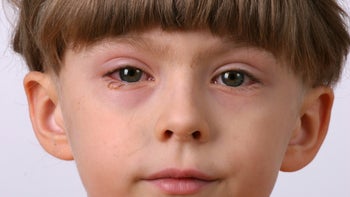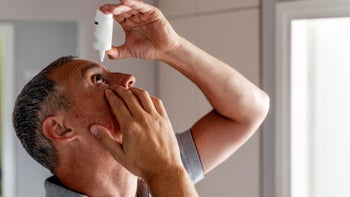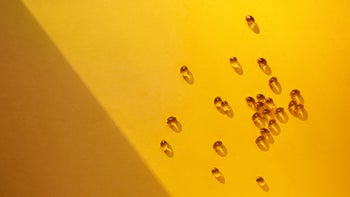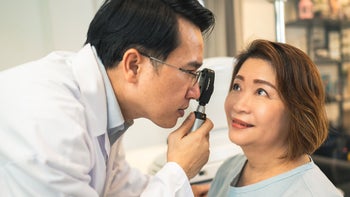
8 At-Home Treatments That Can Relieve Red, Itchy Eyes
Key takeaways:
Common causes of red, itchy eyes include allergies, dry eye, and irritation from contact lenses.
Over-the-counter and home remedies like cool compresses, lubricating eye drops, and allergy eye drops can help relieve red, itchy eyes.
If at-home treatments don’t work or you notice eye pain or vision changes, see an eye doctor right away.
Table of contents

Many people experience red, itchy eyes once in a while. That gritty or burning sensation can make it hard to get through your day. If you’ve been noticing an uptick in your eye symptoms, here are eight at-home treatments that can help bring you relief from red, itchy eyes.
What causes red itchy eyes?
There are many reasons your eyes might be bloodshot or itchy, including:
Contact lenses irritation
Pink eye (Conjunctivitis)
Search and compare options
Understanding the cause of your itchy, red eyes can help you pick out the best treatment options. Here are some questions to ask yourself:
Do you wear contact lenses? If so, your contact lenses or your contact lens solution may be causing your symptoms.
Do your eyes itch and burn all the time, or only if you’re around triggers? Things like pollen, smoke, or perfumes can irritate your eyes. This can be a sign of allergies.
Do you notice burning, tearing, and/or a gritty sensation? This can be a sign of dry eye disease.
Did you start using new cosmetic products? Maybe your red, itchy eyes started after using new eye creams, makeup, or other products that go near your eyes. If so, this can be a sign of a new contact allergy.
Do you have eye discharge? This can be a sign of pink eye.
If you answered “yes” to more than one question, it’s possible that more than one thing is contributing to your red, itchy eyes.
What are some treatments for red, itchy eyes?
But no matter what’s irritating your eyes, many at-home treatments can help relieve eye itchiness, burning, and grittiness. Here are some things to try at home:
1. Cool compress
A cool compress can relieve red, itchy eyes. The cool temperature does double duty. It soothes irritation and itchiness while also tightening blood vessels. This reduces redness and inflammation and can even help relieve eyelid puffiness.
To make and apply a cool compress:
Soak a clean, small towel or cloth in cool water.
Lay it directly over your eyelids.
Keep it in place for about 5 minutes.
Repeat this process throughout the day as needed. Just make sure to use a clean cloth each time.
You can also try cucumber slices since they pack the added benefit of antioxidants. Just don’t freeze them first. Frozen items can damage the delicate skin around your eyes.
Read more like this
Explore these related articles, suggested for readers like you.
2. Warm compress
If you have an ingrown eyelash or a stye, try a warm compress instead of a cool one. The warmth can help open the area and allow drainage. This can relieve and soothe eye irritation and redness.
For a warm compress:
Fill a sock with dry white rice.
Microwave it for 15 seconds.
Check to make sure the sock isn’t too hot.
Lay it directly over your eyelids for about 5 minutes.
You can repeat this process throughout the day.
You can also try reusable warm packs made especially for eyes, like Bruder Mask, MediViz Eye Mask, and Medcosa Heat Eye Bag.
3. Lubricating eye drops
Lubricating eye drops work like extra tears. They keep your eyes moist and soothe itchiness, especially if you have dry eye. They’re also available as gel and ointments for extra moisture. However, these options are better for use before bedtime, since they can blur your vision.
Popular over-the-counter brands include:
4. Eyelid scrubs
Daily eyelid scrubs can soothe red, itchy eyes from blepharitis and dry eye. They do this by keeping your oil glands from clogging.
To make an eyelid scrub:
Mix warm water with a gentle cleanser. Opt for one without fragrance or dyes such as baby shampoo. You can also find specially formulated eyelid scrubs over the counter, like Ocusoft.
Dip a clean cloth, cotton pad, or cotton swab in your mix.
Gently rub against your eyelash line for 10 seconds.
Repeat the process using clean water to get the soap off.
5. Allergy eye drops
Allergy eye drops can provide quick, long-lasting relief from eye allergies that cause itching and redness. Antihistamine eye drops are available over the counter and by prescription. Popular antihistamine eye drops include:
Alaway (ketotifen 0.025%)
Clear Eyes Once Daily Eye Allergy Itch Relief (olopatadine 0.2%)
Extra Strength Pataday Once Daily Relief (olopatadine 0.7%)
Pataday Once Daily Relief (olopatadine 0.2%)
Pataday Twice A Day Relief (olopatadine 0.1%)
Zaditor (ketotifen 0.025%)
Decongestant eye drops can also help relieve eye itching, redness, and dryness. These are available over the counter, but they should only be used for 2 to 3 days. These drops can stop working over time and also cause damage to the eye blood vessels.
6. New contact lenses care routine
If you rely on contact lenses, sticking to a good care routine is key for healthy eyes. Make sure you’re taking the best care of your lenses possible by removing them at night and replacing them as directed. Double down on contact lens cleaning. Always rub and rinse your contacts, even if you’re using a “no rub” formula.
Some tips for good contact lens use:
Make sure to only use sterile saline for contact lens storage.
Never use tap water to clean your contact lenses or your case.
Leave your case open during the day so it has time to dry out completely.
And replace your case every 3 months.
7. Sunglasses
Sunglasses that block UV light protect your eyes from harmful rays. But they also help block allergens like pollen, dust, and mold spores from getting into your eyes. Allergens can make your eyes red, itchy, and watery, especially if you have seasonal allergies.
8. Saline eye flushes
Saline eye flushes can help flush out allergens like pollen, mold spores, and pet dander — even particles from smoke and perfume. If you have allergies, try a saline flush after you’ve been outdoors or around your triggers.
To use a saline flush:
Wash your hands.
Take out your contacts (if you’re wearing them).
Tip your head to the side.
Gently pour some sterile saline into your eye, letting it come out the other side.
It’s OK to blink. Don’t force yourself to keep your eyes open.
Tip your head in the other direction and repeat by flushing out the other eye.
Always use sterile saline that’s meant for eye care. Don’t use homemade saline or tap water to flush your eyes.
When should you see a doctor for red, itchy eyes?
Red, itchy eyes aren’t usually a sign of something serious. But see an eye doctor right away if you notice any vision changes, eye pain, or sudden sensitivity to light. These can be signs of a more serious eye condition.
If home remedies haven’t helped after 2 or 3 days, it’s time to see your eye doctor. You’ll need an eye exam to help figure out what’s causing your eye symptoms. Your eye doctor may also suggest prescription treatment options to relieve your eye symptoms.
The bottom line
Red, itchy eyes can be a sign of a medical condition like allergies or dry eye. There are several red, itchy eye treatments you can try at home like warm and cool compresses, saline eye rinses, and over-the-counter eye drops. But if your symptoms don’t get better within 2 or 3 days with home care treatments, it’s time to seek care from an eye doctor. If you wear contact lenses, sticking to a good care routine can help, too.
Why trust our experts?



References
Alcon Laboratories, Inc. (2022). Pataday once daily relief [package insert]. DailyMed.
Alcon Laboratories, Inc. (2022). Pataday twice a day relief [package insert]. DailyMed.
Alcon Laboratories, Inc. (2023). Systane balance [package insert]. DailyMed.
Alcon Laboratories, Inc. (2022). Zaditor [package insert]. DailyMed.
Allergan, Inc. (2022). Refresh classic [package insert]. DailyMed.
Bausch & Lomb Incorporated. (2022). Alaway [package insert]. DailyMed.
Boyd, K. (2022). How to take care of contact lenses. American Academy of Ophthalmology.
Kuryan, J., et al. (2010). The itchy eye: Diagnosis, management of ocular pruritus. American Academy of Ophthalmology.
Manhattan Eye Specialists. (n.d.). Ingrown eyelash (trichiasis).
Medtech Products, Inc. (2022). Theratears [package insert]. DailyMed.
National Eye Institute. (2020). Blepharitis.
Prestige Brands Holdings, Inc. (2017). Clear eyes natural tears [package insert]. DailyMed.
Prestige Brands Holdings, Inc. (2021). Clear eyes once daily eye allergy itch relief [package insert]. DailyMed.







